Study of Magnesium Activation Effect on Pinch-Off Voltage of Normally-Off p-GaN HEMTs for Power Applications
Abstract
:1. Introduction
2. Materials and Methods
2.1. TCAD Simulations
- In the first DoE, the structure has been simulated with different levels of Mg concentration. All the Mg profiles shared no Mg out-diffusion in the AlGaN barrier, as shown in Figure 3.
- 2.
- A second DoE has been performed by fixing the value of the acceptor concentration in p-GaN and comparing the different out-diffusion profiles in the AlGaN/GaN region: the different profiles have been simulated starting from an experimental out-diffusion shape (Figure 5 (a), red line) and then simply shifting the profile “tail” deeper into the AlGaN/GaN region. The results are shown in Figure 5, where it is clearly visible how the out-diffusion can influence both the pinch-off and threshold voltage. This is because the out-diffused acceptor concentration further counteracts the 2DEG density formation, thus increasing VPO (this effect has been also reported in the literature [14,21]).
2.2. Analysis of CV Measurements
2.3. Different GaN Cap Processings
- reference process, where no intentional magnesium doping has been introduced in the GaN cap;
- single-RTP process, characterized by an intentional Mg doping (ranging from 0.5 × 1019 cm−3 to 2 × 1019 cm−3) during the epitaxial growth of the GaN cap and a standard Rapid Thermal Processing (RTP) for Mg activation (temperature in the range of 700–850 °C for a time duration of 1–10 min), performed after the p-GaN growth;
- multiple-RTP process, featuring intentional Mg doping during the epitaxial growth of the GaN cap and an improved RTP for Mg activation (similar conditions as in the single-RTP process, but the activation process is performed several times during the device process flow).
3. Results and Discussion
3.1. Comparison between Undoped and p-Doped GaN Cap Layer
- A.
- in the first region, coincident with the full p-GaN dimension, the Mg concentration is at the same level of the hydrogen (H) concentration. As reported in the literature, Mg and H can form a bond (Mg–H complexes), preventing Mg to act as an acceptor [26]. Therefore, the flatness of the CV measurement can be well explained by the very low active Mg induced by high H levels in p-GaN;
- B.
- the second region, corresponding to the AlGaN barrier position, shows a difference between Mg and H concentrations, where Mg is consistently higher than H, suggesting a non-zero Mg-induced acceptor concentration close to the AlGaN barrier. This finding, as studied in the previous section, can justify a positive shift of VPO with respect to a fully undoped GaN cap (reference process), as observed in both the CV and IV measurements (Figure 7).
3.2. Comparison between Standard and Improved RTP
4. Conclusions
- whether the active Mg concentration in p-GaN is high or low, there can be an indirect influence of the Mg doping level on the VPO via its out-diffusion in the AlGaN barrier;
- if the active Mg concentration in p-GaN is rather low, the depletion width of the Schottky junction can cover the whole p-GaN dimension, reaching the AlGaN barrier, and thus pull down the entire band diagram (VPO lowering);
- if the active Mg concentration in p-GaN is high enough to induce a depletion width shorter than the full p-GaN height, there will be no direct dependence of VPO on the Mg doping level nor on the Schottky barrier height.
Author Contributions
Funding
Data Availability Statement
Acknowledgments
Conflicts of Interest
References
- Mishra, U.K.; Parikh, P.; Wu, Y.F. AlGaN/GaN HEMTs—An Overview of Device Operation and Applications. Proc. IEEE 2002, 90, 1022–1031. [Google Scholar] [CrossRef]
- Mishra, U.K.; Shen, L.; Kazior, T.E.; Wu, Y.F. GaN-Based RF Power Devices and Amplifiers. Proc. IEEE 2008, 96, 287–305. [Google Scholar] [CrossRef]
- Meneghini, M.; Tajalli, A.; Moens, P.; Banerjee, A.; Zanoni, E.; Meneghesso, G. Trapping phenomena and degradation mechanisms in GaN-based power HEMTs. Mater. Sci. Semicond. Process. 2018, 78, 118–126. [Google Scholar] [CrossRef]
- Ambacher, O.; Foutz, B.; Smart, J.; Shealy, J.R.; Weimann, N.G.; Chu, K.; Murphy, M.; Sierakowski, A.J.; Schaff, W.J.; Eastman, L.F.; et al. Two dimensional electron gases induced by spontaneous and piezoelectric polarization in undoped and doped AlGaN/GaN heterostructures. J. Appl. Phys. 2000, 87, 334–344. [Google Scholar] [CrossRef]
- Ambacher, O.; Smart, J.; Shealy, J.R.; Weimann, N.G.; Chu, K.; Murphy, M.; Schaff, W.J.; Eastman, L.F.; Dimitrov, R.; Wittmer, L.; et al. Two-dimensional electron gases induced by spontaneous and piezoelectric polarization charges in N- and Ga-face AlGaN/GaN heterostructures. J. Appl. Phys. 1999, 85, 3222–3233. [Google Scholar] [CrossRef]
- Meneghini, M.; De Santi, C.; Abid, I.; Buffolo, M.; Cioni, M.; Khadar, R.A.; Nela, L.; Zagni, N.; Chini, A.; Medjdoub, F.; et al. GaN-based power devices: Physics, reliability, and perspectives. J. Appl. Phys. 2021, 130, 181101. [Google Scholar] [CrossRef]
- Roccaforte, F.; Greco, G.; Fiorenza, P.; Iucolano, F. An Overview of Normally-Off GaN-Based High Electron Mobility Transistors. Materials 2019, 12, 1599. [Google Scholar] [CrossRef] [PubMed]
- Greco, G.; Iucolano, F.; Roccaforte, F. Review of technology for normally-off HEMTs with p-GaN gate. Mater. Sci. Semicond. Process. 2018, 78, 96–106. [Google Scholar] [CrossRef]
- Uemoto, Y.; Hikita, M.; Ueno, H.; Matsuo, H.; Ishida, H.; Yanagihara, M.; Ueda, T.; Tanaka, T.; Ueda, D. Gate injection transistor (GIT)—A normally-off AlGaN/GaN power transistor using conductivity modulation. IEEE Trans. Electron Devices 2007, 54, 3393–3399. [Google Scholar] [CrossRef]
- Kumar, A.; Berg, M.; Wang, Q.; Salter, M.; Ramvall, P. Growth of p-type GaN—The role of oxygen in activation of Mg-doping. Power Electron. Devices Compon. 2023, 5, 100036. [Google Scholar] [CrossRef]
- SILVACO. ATLAS User’ s Manual (Device Simulation Software); SILVACO: Santa Clara, CA, USA, 2019. [Google Scholar]
- Iucolano, F.; Greco, G.; Roccaforte, F. Correlation between microstructure and temperature dependent electrical behavior of annealed Ti/Al/Ni/Au Ohmic contacts to AlGaN/GaN heterostructures. Appl. Phys. Lett. 2013, 103, 201604. [Google Scholar] [CrossRef]
- Greco, G.; Fiorenza, P.; Giannazzo, F.; Bongiorno, C.; Moschetti, M.; Bottari, C.; Alessandrino, M.S.; Iucolano, F.; Roccaforte, F. Threshold voltage instability by charge trapping effects in the gate region of p-GaN HEMTs. Appl. Phys. Lett. 2022, 121, 233506. [Google Scholar] [CrossRef]
- Bakeroot, B.; Stockman, A.; Posthuma, N.; Stoffels, S.; Decoutere, S. Analytical Model for the Threshold Voltage of p-(Al)GaN High-Electron-Mobility Transistors. IEEE Trans. Electron Devices 2018, 65, 79–86. [Google Scholar] [CrossRef]
- Garcia, F.; Shamsir, S.; Islam, S.K. A compact model and TCAD simulation for GaN-gate injection transistor (GIT). Solid-State Electron. 2019, 151, 52–59. [Google Scholar] [CrossRef]
- SILVACO. ATHENA User’ s Manual (Process Simulation Software); SILVACO: Santa Clara, CA, USA, 2015. [Google Scholar]
- Farahmand, M.; Garetto, C.; Bellotti, E.; Brennan, K.; Goano, M.; Ghillino, E.; Ghione, G.; Albrecht, J.; Ruden, P. Monte Carlo simulation of electron transport in the III-nitride wurtzite phase materials system: Binaries and ternaries. IEEE Trans. Electron Devices 2001, 48, 535–542. [Google Scholar] [CrossRef]
- Kakanakova-Georgieva, A.; Papamichail, A.; Stanishev, V.; Darakchieva, V. Incorporation of Magnesium into GaN Regulated by Intentionally Large Amounts of Hydrogen during Growth by MOCVD. Phys. Status Solidi (b) 2022, 259, 2200137. [Google Scholar] [CrossRef]
- Jaud, M.-A.; Baines, Y.; Charles, M.; Morvan, E.; Scheiblin, P.; Torres, A.; Plissonnier, M.; Barbe, J.-C. TCAD for gate stack optimization in pGaN Gate HEMT devices. In Proceedings of the 2017 International Conference on Simulation of Semiconductor Processes and Devices (SISPAD), Kamakura, Japan, 7–9 September 2017; pp. 205–208. [Google Scholar]
- Liou, J.J.; Ortiz-Conde, A.; Garcia-Sanchez, F. Analysis and Design of MOSFETs: Modeling, Simulation and Parameter Extraction; Kluwer Academic Publishers: New York, NY, USA, 1998. [Google Scholar]
- Posthuma, N.E.; You, S.; Liang, H.; Ronchi, N.; Kang, X.; Wellekens, D.; Saripalli, Y.N.; Decoutere, S. Impact of Mg out-diffusion and activation on the p-GaN gate HEMT device performance. In Proceedings of the 2016 28th International Symposium on Power Semiconductor Devices and ICs (ISPSD), Prague, Czech Republic, 12–16 June 2016. [Google Scholar]
- Hilibrand, J.; Gold, R.D. Determination of the Impurity Distribution in Junction Diodes From Capacitance-Voltage Measurements. RCA Rev. 1960, 21, 245. [Google Scholar]
- Padovani, F.; Stratton, R. Field and thermionic-field emission in Schottky barriers. Solid-State Electron. 1966, 9, 695–707. [Google Scholar] [CrossRef]
- Greco, G.; Iucolano, F.; Di Franco, S.; Bongiorno, C.; Patti, A.; Roccaforte, F. Effects of Annealing Treatments on the Properties of Al/Ti/p-GaN Interfaces for Normally OFF p-GaN HEMTs. IEEE Trans. Electron Devices 2016, 63, 2735–2741. [Google Scholar] [CrossRef]
- Modolo, N.; Tang, S.W.; Jiang, H.J.; De Santi, C.; Meneghini, M.; Wu, T.L. A Novel Physics-Based Approach to Analyze and Model E-Mode p-GaN Power HEMTs. IEEE Trans. Electron Devices 2021, 68, 1489–1494. [Google Scholar] [CrossRef]
- Youn, D.-H.; Lachab, M.; Hao, M.; Sugahara, T.; Takenaka, H.; Naoi, Y.; Sakai, S. Investigation on the P-Type Activation Mechanism in Mg-doped GaN Films Grown by Metalorganic Chemical Vapor Deposition. Jpn. J. Appl. Phys. 1999, 38, 631–634. [Google Scholar] [CrossRef]
- Chen, K.J.; Häberlen, O.; Lidow, A.; lin Tsai, C.; Ueda, T.; Uemoto, Y.; Wu, Y. GaN-on-Si Power Technology: Devices and Applications. IEEE Trans. Electron Devices 2017, 64, 779–795. [Google Scholar] [CrossRef]
- Tallarico, A.N.; Stoffels, S.; Posthuma, N.; Decoutere, S.; Sangiorgi, E.; Fiegna, C. Threshold Voltage Instability in GaN HEMTs with p-type Gate: Mg Doping Compensation. IEEE Electron Device Lett. 2019, 40, 518–521. [Google Scholar] [CrossRef]

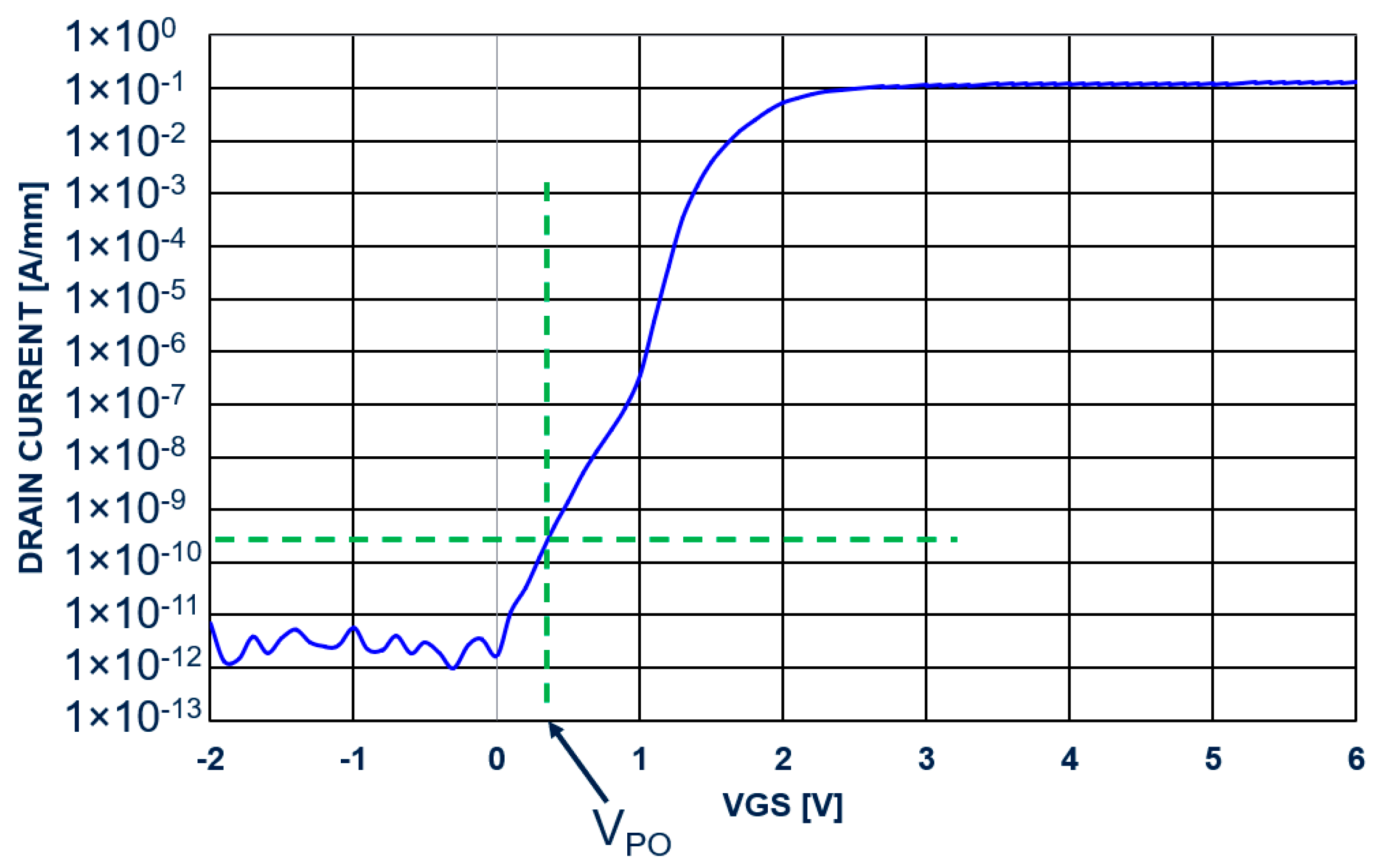
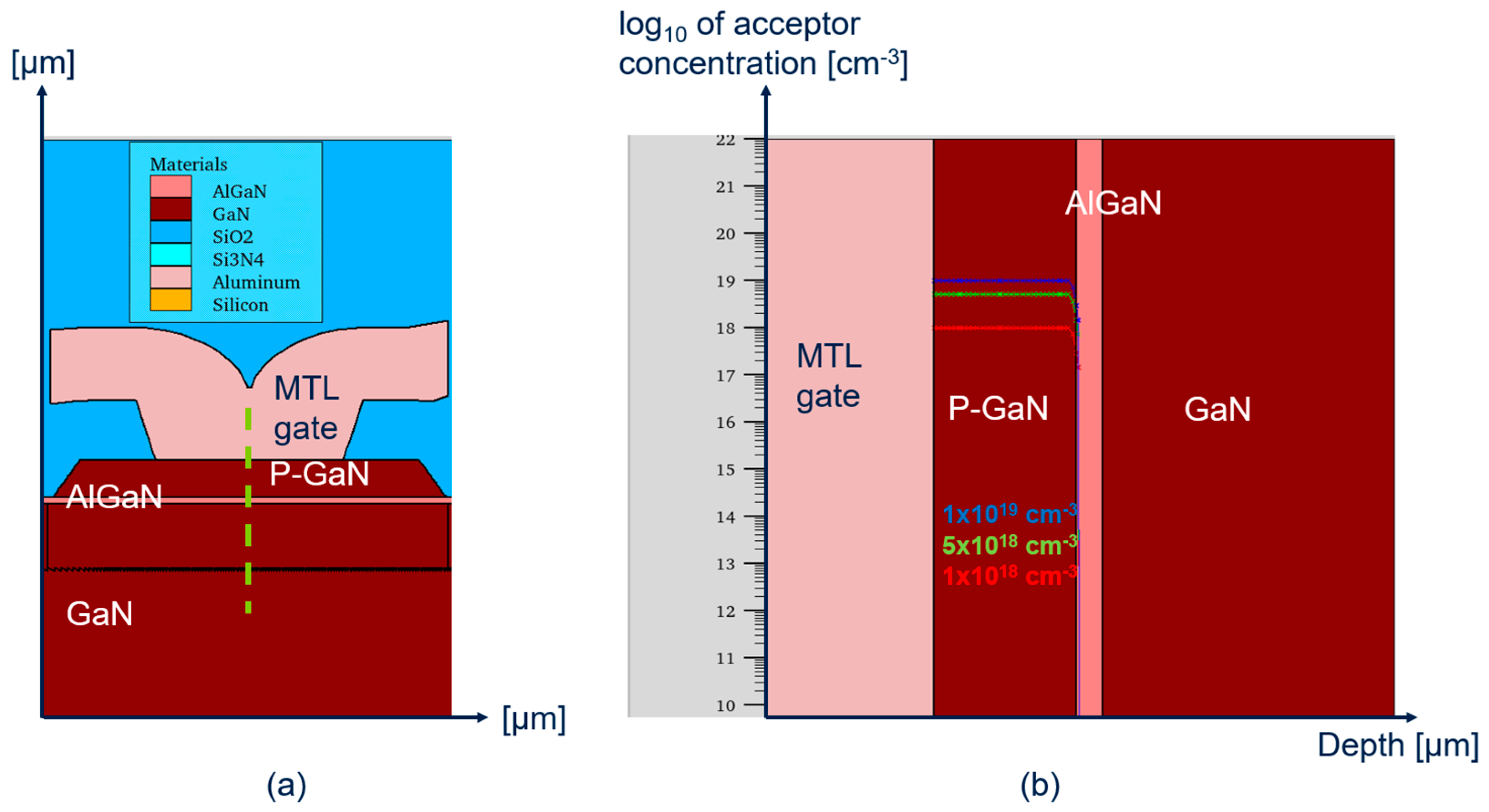



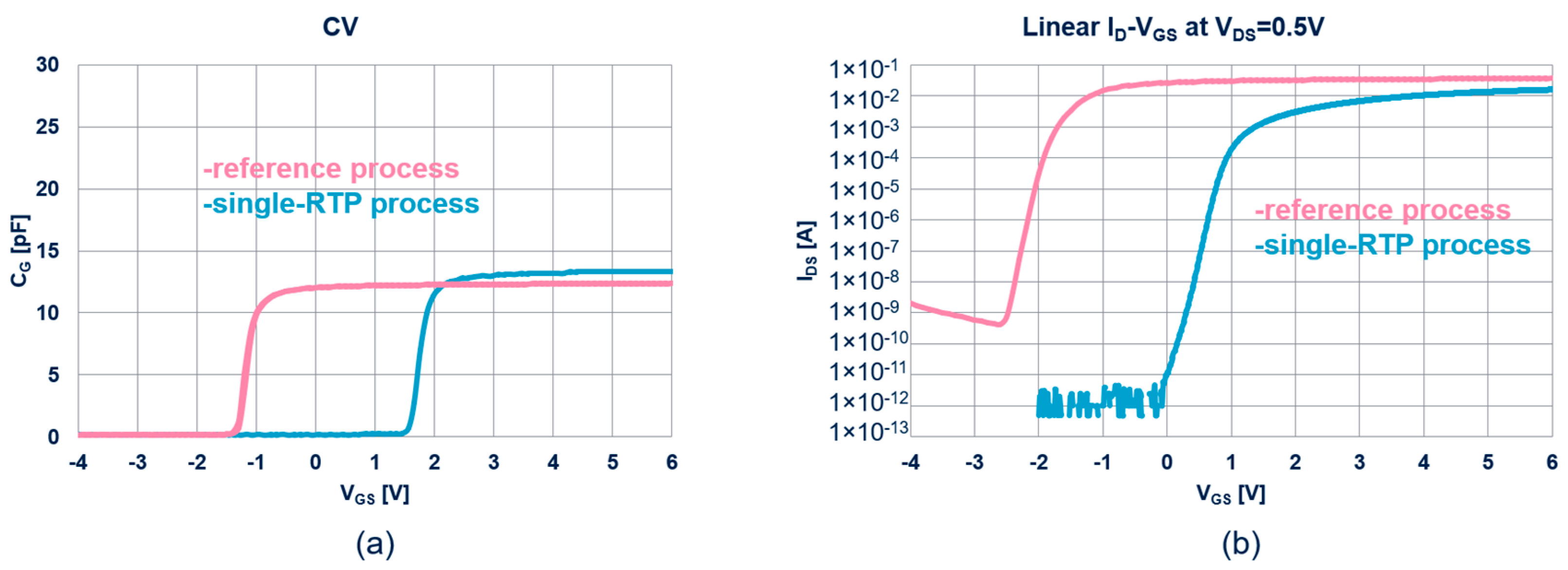


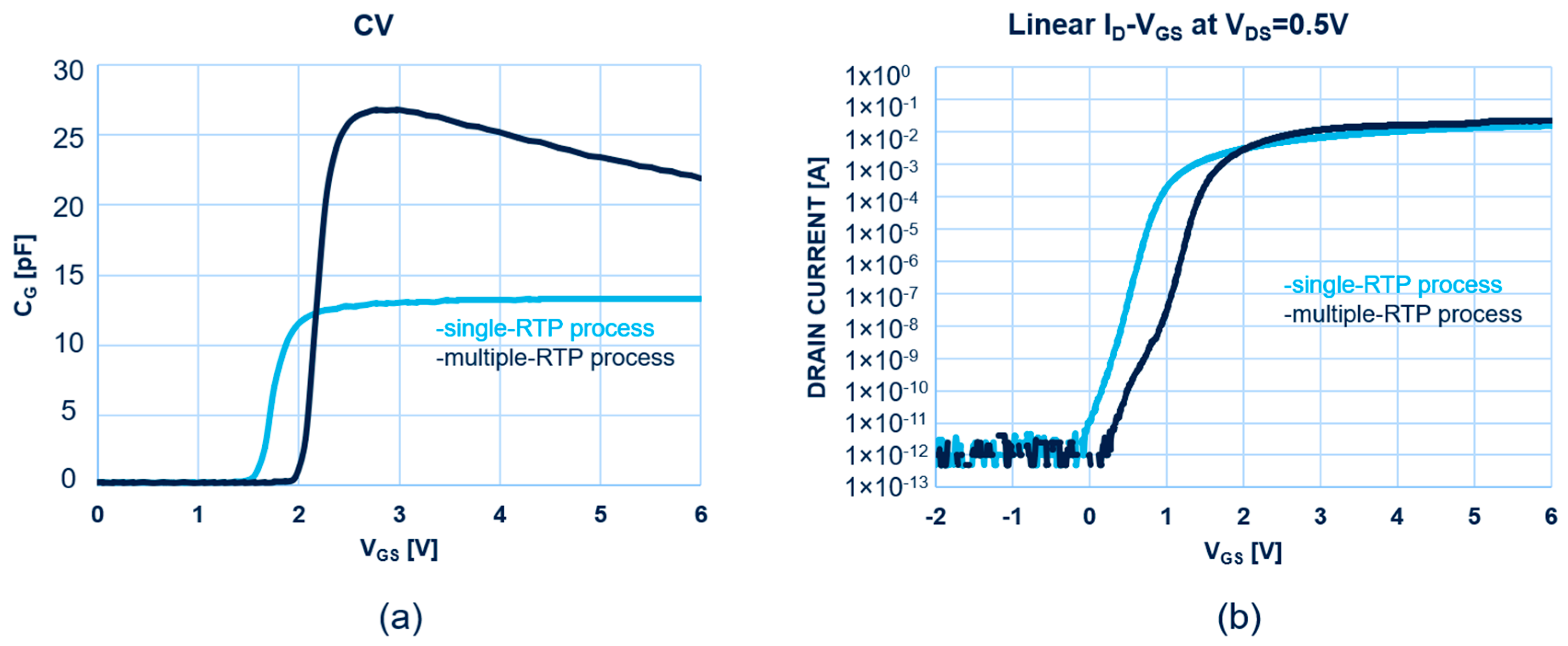
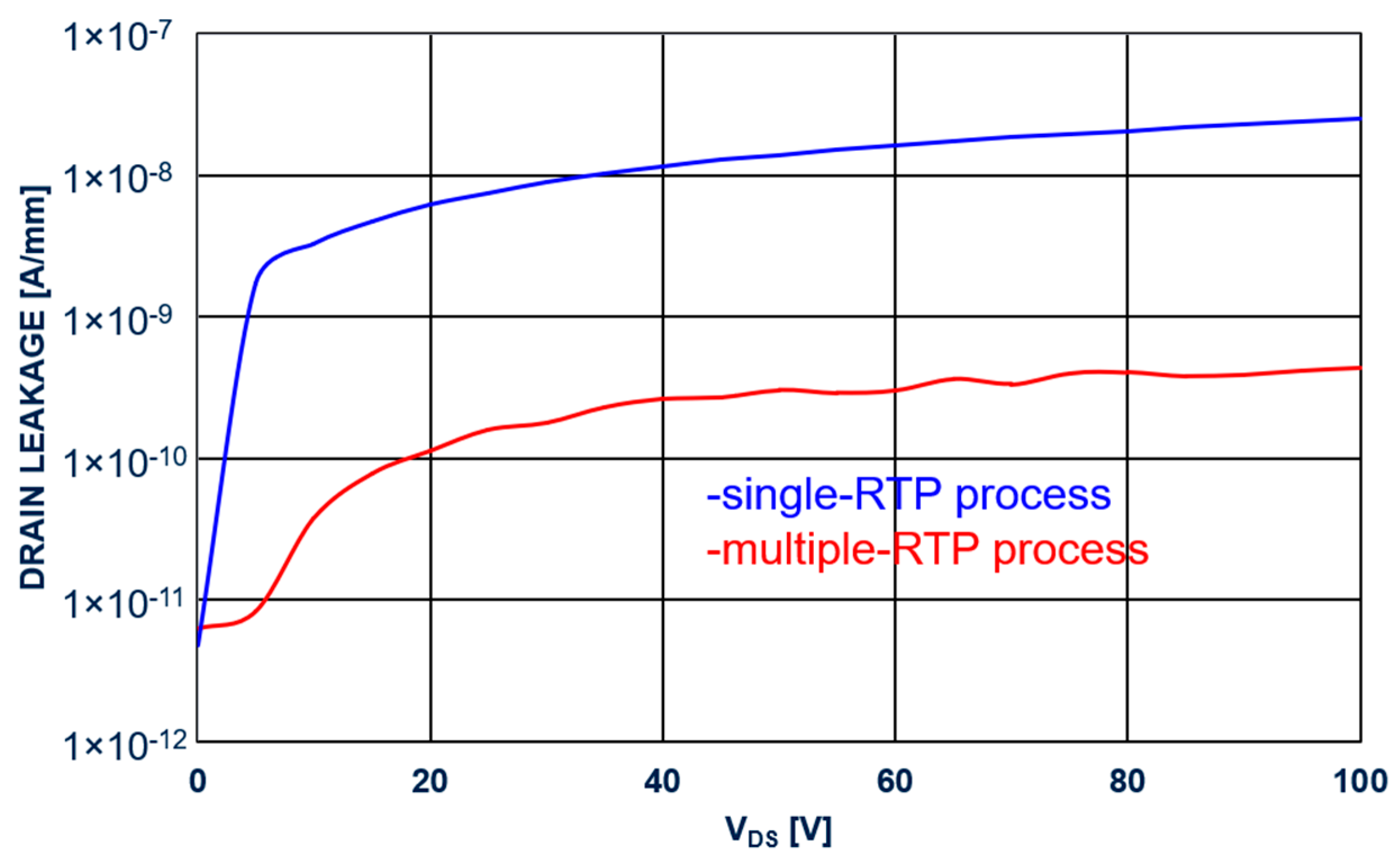


Disclaimer/Publisher’s Note: The statements, opinions and data contained in all publications are solely those of the individual author(s) and contributor(s) and not of MDPI and/or the editor(s). MDPI and/or the editor(s) disclaim responsibility for any injury to people or property resulting from any ideas, methods, instructions or products referred to in the content. |
© 2023 by the authors. Licensee MDPI, Basel, Switzerland. This article is an open access article distributed under the terms and conditions of the Creative Commons Attribution (CC BY) license (https://creativecommons.org/licenses/by/4.0/).
Share and Cite
Giorgino, G.; Greco, G.; Moschetti, M.; Miccoli, C.; Castagna, M.E.; Tringali, C.; Fiorenza, P.; Roccaforte, F.; Iucolano, F. Study of Magnesium Activation Effect on Pinch-Off Voltage of Normally-Off p-GaN HEMTs for Power Applications. Crystals 2023, 13, 1309. https://doi.org/10.3390/cryst13091309
Giorgino G, Greco G, Moschetti M, Miccoli C, Castagna ME, Tringali C, Fiorenza P, Roccaforte F, Iucolano F. Study of Magnesium Activation Effect on Pinch-Off Voltage of Normally-Off p-GaN HEMTs for Power Applications. Crystals. 2023; 13(9):1309. https://doi.org/10.3390/cryst13091309
Chicago/Turabian StyleGiorgino, Giovanni, Giuseppe Greco, Maurizio Moschetti, Cristina Miccoli, Maria Eloisa Castagna, Cristina Tringali, Patrick Fiorenza, Fabrizio Roccaforte, and Ferdinando Iucolano. 2023. "Study of Magnesium Activation Effect on Pinch-Off Voltage of Normally-Off p-GaN HEMTs for Power Applications" Crystals 13, no. 9: 1309. https://doi.org/10.3390/cryst13091309
APA StyleGiorgino, G., Greco, G., Moschetti, M., Miccoli, C., Castagna, M. E., Tringali, C., Fiorenza, P., Roccaforte, F., & Iucolano, F. (2023). Study of Magnesium Activation Effect on Pinch-Off Voltage of Normally-Off p-GaN HEMTs for Power Applications. Crystals, 13(9), 1309. https://doi.org/10.3390/cryst13091309








